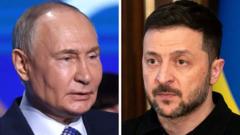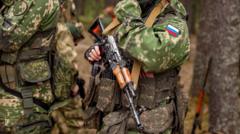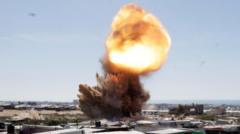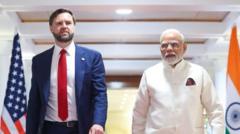Efforts to negotiate a ceasefire in the Ukraine war gain momentum, but significant hurdles and differing agendas stand in the way, with each stakeholder holding firm on crucial issues.
**US Diplomacy Accelerates to End Ukraine Conflict Despite Uncertainties**
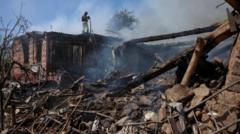
**US Diplomacy Accelerates to End Ukraine Conflict Despite Uncertainties**
As diplomatic discussions intensify, the future of peace in Ukraine remains uncertain amid varied expectations from all parties involved.
As diplomatic initiatives to cease hostilities in Ukraine escalate, key representatives of the UK, Germany, France, Ukraine, and the US convene in London, while former US envoy Steve Witkoff prepares for another meeting with President Putin in Moscow. Despite the flurry of activity, there is a notable absence of clarity surrounding the outcomes of these negotiations.
Previously, the US articulated a straightforward proposal to bring an end to the conflict: a swift, unconditional ceasefire for 30 days, followed by discussions aimed at achieving a lasting resolution. Ukraine consented to this approach, making significant concessions by waiving the prerequisite of future security guarantees to halt the fighting. However, Russia remains non-compliant, demanding its terms be met before any ceasefire can be established. President Putin emphasizes the need to address what he describes as "root causes" of the war, especially his concerns regarding NATO expansion and the perception of Ukrainian statehood as a threat.
Reportedly, the US is currently negotiating a ceasefire framework wherein Russia would cease its military operations in existing occupied territories while retaining de facto control over them, along with Crimea, which was annexed in 2014. In return, the US would acknowledge these territorial adjustments and assure Ukraine does not seek NATO membership. Moreover, the US may take control of the Zaporizhzhia nuclear facility to supply both Ukrainian territories with electricity, a critical point of contention.
However, this framework faces grave challenges even at a glance. Ukrainian President Zelensky has firmly stated that there is no way Ukraine will ever recognize Crimea as Russian territory, a stance supported by European governments who fear that conceding such sovereignty could set a dangerous precedent against international law. Additionally, US legislative hurdles complicate the legality of formally recognizing Crimea as part of Russia, should it come to that.
Despite the ongoing skepticism, some Western diplomats express a cautiously optimistic view, suggesting that negotiation avenues still exist, but there are substantial trust barriers to overcome. The leak of the proposed deal highlights essential gaps: no prohibition against western nations rearming Ukraine and no commitment from Russia regarding the demilitarization of Ukraine’s armed forces, which Russia has long demanded as part of any peace agreement.
While the proposal restricts Ukraine’s NATO ambitions, it does allow for potential EU membership and the deployment of a European reassurance force to the western part of the country post-ceasefire. The parameters for lifting economic sanctions against Russia remain ambiguous, raising further uncertainties about the deal's sustainability.
The parties currently diverge significantly on their demands. Ukraine insists on a conditional ceasefire, while the US pushes for a swift resolution, and Russia is focused on detailed negotiations. The age-old Russian adage, “nothing is agreed until everything is agreed,” resonates distinctly at this juncture, highlighting the daunting task of arriving at a consensus within the current impasse.
Previously, the US articulated a straightforward proposal to bring an end to the conflict: a swift, unconditional ceasefire for 30 days, followed by discussions aimed at achieving a lasting resolution. Ukraine consented to this approach, making significant concessions by waiving the prerequisite of future security guarantees to halt the fighting. However, Russia remains non-compliant, demanding its terms be met before any ceasefire can be established. President Putin emphasizes the need to address what he describes as "root causes" of the war, especially his concerns regarding NATO expansion and the perception of Ukrainian statehood as a threat.
Reportedly, the US is currently negotiating a ceasefire framework wherein Russia would cease its military operations in existing occupied territories while retaining de facto control over them, along with Crimea, which was annexed in 2014. In return, the US would acknowledge these territorial adjustments and assure Ukraine does not seek NATO membership. Moreover, the US may take control of the Zaporizhzhia nuclear facility to supply both Ukrainian territories with electricity, a critical point of contention.
However, this framework faces grave challenges even at a glance. Ukrainian President Zelensky has firmly stated that there is no way Ukraine will ever recognize Crimea as Russian territory, a stance supported by European governments who fear that conceding such sovereignty could set a dangerous precedent against international law. Additionally, US legislative hurdles complicate the legality of formally recognizing Crimea as part of Russia, should it come to that.
Despite the ongoing skepticism, some Western diplomats express a cautiously optimistic view, suggesting that negotiation avenues still exist, but there are substantial trust barriers to overcome. The leak of the proposed deal highlights essential gaps: no prohibition against western nations rearming Ukraine and no commitment from Russia regarding the demilitarization of Ukraine’s armed forces, which Russia has long demanded as part of any peace agreement.
While the proposal restricts Ukraine’s NATO ambitions, it does allow for potential EU membership and the deployment of a European reassurance force to the western part of the country post-ceasefire. The parameters for lifting economic sanctions against Russia remain ambiguous, raising further uncertainties about the deal's sustainability.
The parties currently diverge significantly on their demands. Ukraine insists on a conditional ceasefire, while the US pushes for a swift resolution, and Russia is focused on detailed negotiations. The age-old Russian adage, “nothing is agreed until everything is agreed,” resonates distinctly at this juncture, highlighting the daunting task of arriving at a consensus within the current impasse.











